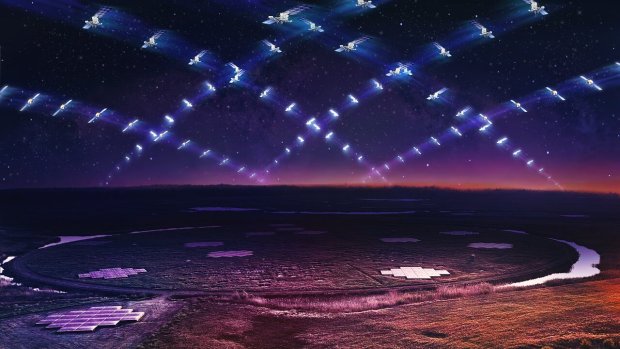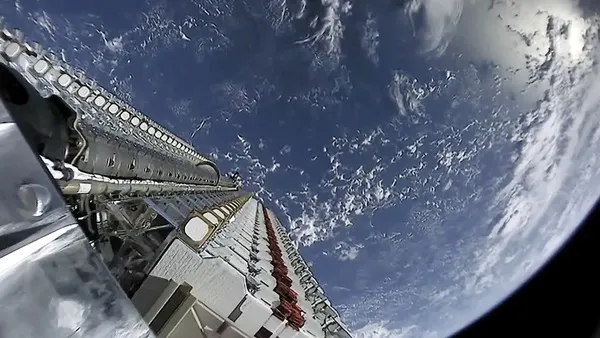Starlink satellites are causing interference with astronomical research.
A recent study published in Astronomy and Astrophysics has revealed that the extensive fleet of Starlink satellites is causing interference with astronomical observations. When astrophysicists utilized the Low-Frequency Array (LOFAR) telescope in the northern Netherlands to observe 68 of SpaceX’s satellites, they detected unintended electromagnetic radiation emanating from the satellites’ onboard electronics.
The potential impact of these large constellations of satellites on data collection and observations is now receiving increased attention from experts and being more carefully examined. Federico Di Vruno, the spectrum manager at the Square Kilometre Array Observatory (SKAO) and author of the study, emphasizes the need for preparedness and understanding regarding the potential effects of these extremely large constellations if they are ever launched.
Di Vruno highlights that the vast number of planned satellites, which could reach hundreds of thousands, may significantly interfere with radio astronomy. Starlink, for instance, intends to launch a total of 42,000 satellites, with over 4,000 already in low Earth orbit. Most recently, on July 15, SpaceX’s Falcon 9 launched an additional 54 Starlink satellites into space.

An invisible universe
In the vast expanse of space, there are countless objects that emit various forms of light across the electromagnetic spectrum. These electromagnetic waves propagate through space much like ripples in water. From distant galaxies to vibrant nebulae, and even radio bursts from planets, all of these celestial phenomena emit different types of electromagnetic radiation. To study and understand these phenomena, experts utilize radio telescopes to tune into and amplify these signals, allowing us to gain a comprehensive understanding of the unseen.
Astrophysicists observe these celestial wonders within a specific frequency range, typically between 30 megahertz [MHz] and 300 gigahertz [GHz]. To put it into perspective, scientists could potentially detect signals from a cell phone on the Moon within this frequency range.
While the electromagnetic radiation emitted by SpaceX satellites does have the potential to interfere with Earth-based radio telescopes, Di Vruno, an expert in the field, assures that the level of interference is no greater than that of a television. The real concern for astronomers lies in the sheer number of satellites emitting radiation simultaneously, which creates a significant disruption.
During a recent study, researchers observed 68 satellites and found that 47 of the Starlink satellites emitted radiation within the frequency range of 110 to 188 MHz. This range encroaches upon a protected band allocated by the International Telecommunications Union (ITU) between 150.05 and 153 MHz. However, it is important to note that SpaceX did not violate any regulations protecting radio astronomy, as there are currently no specific rules in place to safeguard terrestrial radio telescopes against radio interference.
These satellite constellations, including the Starlink network, are part of a larger system designed to monitor Earth, provide global communication, and ensure widespread access to broadband internet. Other constellations, such as OneWeb, are also planned for launch, further expanding this global communications network. Currently, OneWeb has 648 satellites positioned in 12 orbital planes within low-Earth orbit.

The leak
All Earth-orbiting satellites engage in the transmission and reception of radio signals to and from Earth in order to establish communication with ground stations. For many years, radio astronomers have grappled with the issue of excessive “noise” caused by these signals. To mitigate the impact of this interference on their research, they employ techniques such as tracking the satellite’s trajectory and avoiding its presence when detecting any disruption in the data.
Recently, SpaceX and the National Science Foundation reached an agreement to minimize interference from Starlink satellites on radio astronomy facilities operating within the frequency range of 10.6 to 10.7 GHz. This agreement specifically benefits institutions like the National Radio Astronomy Observatory and the Green Bank Observatory. Despite the efforts of astrophysicists to work around radio frequency interference, concerns persist regarding the potential radiation leakage from an increasing number of satellites, which could render a significant portion of their data unusable.
Yvette Cendes, a radio astronomer at the Harvard-Smithsonian Center for Astrophysics, explains that radio frequency interference results in a loss of signal quality, leaving researchers with nothing but noise. This means that if an hour-long observation is reduced to just 10 minutes of usable data, the remaining 50 minutes are essentially wasted.
To illustrate the impact of interference, Di Vruno compares it to being in a dark room and suddenly having a bright torch shone directly into your eyes. The sudden blindness and inability to see anything is akin to the challenges faced by astronomers dealing with interference.
Collaborations
The research sheds light on the factors that need to be taken into account as the frequency of large constellation array launches increases. At present, the authors of the study are engaging in discussions with SpaceX to explore potential strategies for minimizing the inadvertent release of radiation. Di Vruno emphasizes the importance of initiating these discussions early on, not only with regulators but also to address the absence of regulations in this area.
This article is republished from astronomy.com under a Creative Commons license. Read the original article.
Do not forget to share your opinion with us to provide you with the best posts !



0 Comments